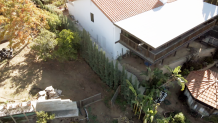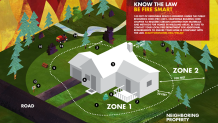Defensible space: anyone who’s lived through a wildfire knows those two words well. They know homes with landscaping clear of brush and flammable vegetation have a better shot of surviving when the next fire sweeps through San Diego County.
But what happens when your neighbor next door doesn’t maintain defensible space along your property line?
Viewers reached out to NBC 7 Investigates asking for help with exactly that predicament after they say they failed to get results on their own. Ultimately, multiple fire districts painted an unsettling picture. Under current California fire code laws, if your neighbor’s landscaping puts your home at risk, there’s just not much you can do.
In one instance, a firefighter with Cal Fire planted dozens of Italian cypress trees within 10 feet of his neighbor’s home in Fallbrook. That neighbor, Kristi Lueking, reached out to NBC 7 Investigates after fire district officials told her their hands were tied.
Get top local stories in San Diego delivered to you every morning. Sign up for NBC San Diego's News Headlines newsletter.
“It’s just not right,” said Lueking. “Sometimes what’s legal isn’t right. This might be legal, but it’s wrong what he did.”

Italian cypress trees are considered highly flammable. They collect dry dead material and burn fast. They appear on the county’s list of undesirable plants – which it advises not to plant within 50 feet of any structure. In fact, the popular landscaping plant’s reputation to ignite is so notorious, many firefighters in Southern California commonly refer to Italian cypress trees by the nickname “Roman candles.”
“Every day I look at them and I feel sick to my stomach,” said Lueking gazing up at the wall of trees planted in front of her bedroom window.
She says her neighbor planted the trees in August after she confronted him over running an Airbnb on his property. NBC 7 Investigates found that Airbnb listing hosted by Jonathan Wolfe. Property records confirm Wolfe owns this home, and government documents confirm Wolfe is a firefighter paramedic with Cal Fire.
What Wolfe did isn’t illegal, according to multiple fire officials.
This month, NBC 7 Investigates attended a special wildfire safety seminar presented by Cal Fire. Laws require homeowners to keep three zones of their properties up to code. Trees aren’t allowed to be planted within 10 feet of your home. They need to be trimmed so that no branches extend into that area. Any other trees that are within 100 feet of your home must also be trimmed. When it comes to grass, it needs to be kept shorter than six inches if it’s within 50 feet of your home.
But Cal Fire Captain Neil Czapinski told us those rules don’t apply to your property line and neighboring structures. Trees can be planted there, even if they are within 10 feet of your neighbor’s home.

“Unfortunately there’s not a whole lot we can do,” said Czapinski. “If you’re that person and you want to have everything up to your property line, that is definitely your ability to do.”
The North County Fire Protection District manages the Fallbrook neighborhood where Lueking and Wolfe live. District officials confirmed to NBC 7 Investigates that Wolfe isn’t breaking any codes, as long as he keeps the trees alive and green and has an irrigation system to keep them watered.
NBC 7 Investigates tried reaching Wolfe at his home, by mail and through his Airbnb inbox. We wanted to ask him about planting dozens of trees that appear on the county’s advisory list near his neighbor's home, but he never responded to us. We asked Cal Fire to comment about the trees their own firefighter planted, but it said it would be inappropriate to comment on a dispute between neighbors.
About 35 miles southeast in Valley Center, another next-door wildfire concern is likely to wind up with better results.
“This is just a big life-threatening situation waiting to happen,” says Dan Scampini showing our crew the acres of dry uncut tall grass neighboring his home.
Scampini would know. He lived through the Paradise fire before moving to Southern California. He owns a cow named Milka as well as other livestock and constantly worries about having enough time to get everyone to safety in the event of a wildfire.
“This is not just tall grass,” says Scampini. “It’s dry, dead tall grass. And one little cigarette, one little spark from any kind of equipment, this will start on fire. It’s a tremendous fire hazard, for not just myself but for all the neighbors around here.”
He says he nervously watched the grass grow as tall as four feet high this spring. The Valley Center Fire Protection District said it issued two notices of violation to his neighbor. After our investigative producer spoke with that man over the phone, he told Scampini and us that he would get the grass cut.
Back in Fallbrook, Lueking is out of options, other than to hope her neighbor has a change of heart. She says she is shocked any neighbor would do this, but especially a firefighter.
“What kind of human being would do this to another person?” asked Lueking.
Living in this Fallbrook home for 20 years, Lueking has seen many wildfires, including a close call on Christmas Eve two years ago that moved many of her neighbors to evacuate. Now the image of embers from the next fire catching on the tree branches surrounding her home is never far from her mind.
“How can I escape? I would be trapped. I feel I would be trapped.”
Cal Fire said the best way to mitigate wildfire risks along property lines is to foster a better relationship with your neighbors. That could include offering to go onto their property to cut grass or remove flammable items. Barring that, they say the best option is to harden your home against fire with fire-resistant building materials or fixtures.
You can read up on defensible space laws here, and learn what you can do to protect your home.



